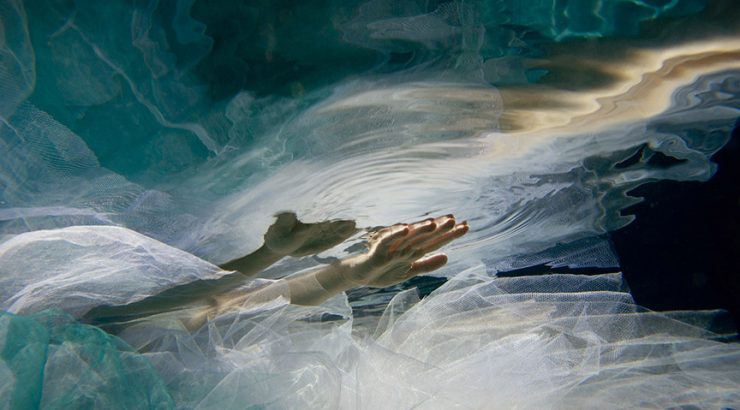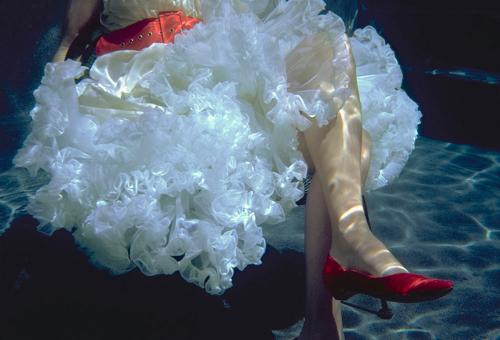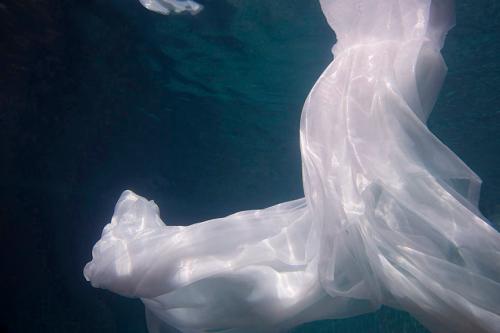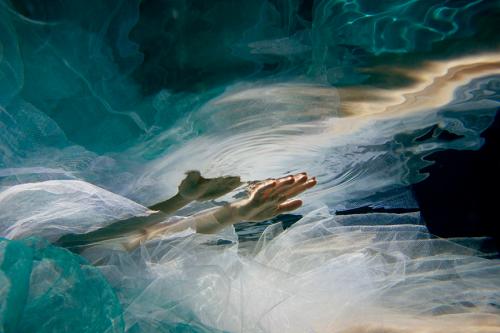
Stillwater— How Three Photographers Suspend an Ever-Moving Element in Time
July 20, 2023
As summer sends thousands fleeing to seas and poolsides, we find ourselves reminded of water’s constant need to move— waves recede, riverbeds race, ice pops drip to the floor. But what happens when artists disobey mother nature and depict water as a fossil, a singular frame frozen in time. Join Wilkinson College’s Escalette Collection of Art in exploring three photographers in our collection who achieved the impossible and suspended this ever-moving element.
Amir Zaki
Sliver 1 by Amir Zaki is almost impossible to properly capture without viewing it in person. The longer one stares at this seemingly common wave, all that is familiar turns unfamiliar, leaving viewers with only questions for this remarkable photographer.
Zaki employs the term “hybrid photography” to describe the techniques utilized in his mind-bending Sliver series. Disobeying the rules of perspective, the horizon line is made ambiguous and all remnants of surrounding land is erased, creating a disorienting sight. Specifically in Sliver 1, Zaki digitally compacts the image. What seems true to life from afar becomes pixelated up close, asking us to question whether this is a photograph or a digital recreation.
Intentionally distorting texture and orientation, Zaki takes what is typical, removes context, and leaves viewers adrift on an endless sea.
Cara Romero

Cara Romero, Eufaula Girls, photograph printed on Legacy Platine paper, 2015. Purchased with acquisition funds.
In Eufaula Girls, an installment of Cara Romero’s stunning series “Water Memories,” Muscogee mother and daughter Lisa and Crickett Tiger are suspended in time, paused amidst their decent towards murky depths. Referencing the floods in Eufaula, Oklahoma, Romero’s photograph suggests that man’s relationship with water is cyclical in nature, with the element both sustaining life and bringing it to an end.
“‘Water Memories’ are photography dreamscapes dealing with Native American relationships to water, the forces of man and of Mother Nature. They are individual explorations of space, memory, and diverse Indigenous narratives that are both terrifying and peaceful.” —Cara Romero
Romero often utilizes photography to present womanhood from uniquely indigenous lens, exploring the Chemehuevi belief that women hold innate strength as life-giver, existing as equals to men. In Eufaula Girls, this belief is upheld, with the mother-daughter pair depicted in a powerful, almost supernatural fashion.
To capture the Tiger women, Romero encases her camera equipment and scuba dove, the non-digital process bringing raw realism to the breathtaking scene.
Kenda North
- Kenda North, Red Shoes #179, ultrachrome pigment print, 2012. Gift of the artist.
- Kenda North, Descent, ultrachrome pigment print, 2012. Gift of the artist.
- Kenda North, Bliss, ultrachrome pigment print, 2012. Gift of the artist.
Kendra North, professor and head of photography at UT Arlington, has worked in pools with an underwater camera for almost 20 years. According to North, it’s the way figures and fabric play definitely in this distinctive environment that keeps bringing her back to the water, such as in her series, “Backyard Desire.”
In these ethereal scenes, water dances through long dresses and scatters natural light in haphazard patterns, distorting the photograph in ways that would not be possible above land. North’s submerged, yet fully dressed subject creates an otherworldly juxtaposition: the fabrics themselves float in weightlessness, despite the waterlogged dresses as a whole sinking North’s subjects further and further into the deep.





